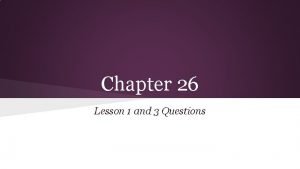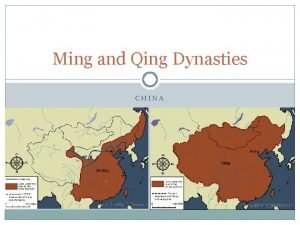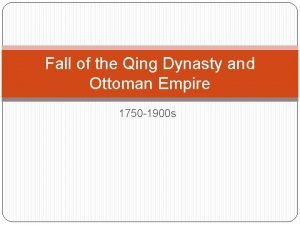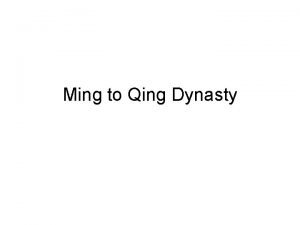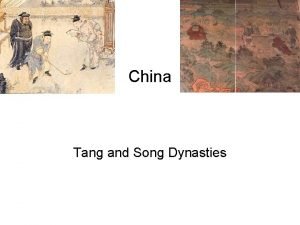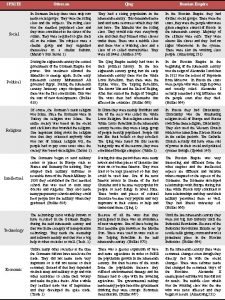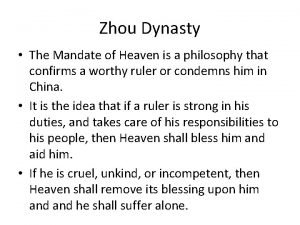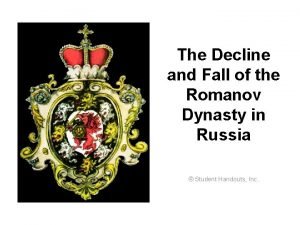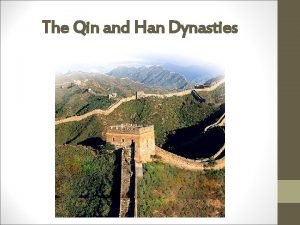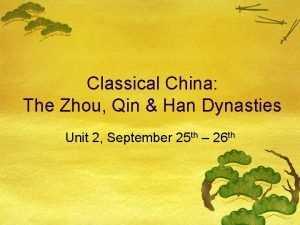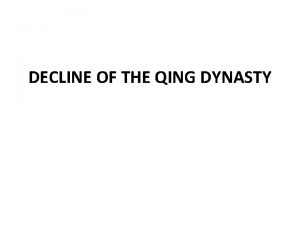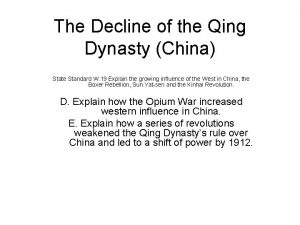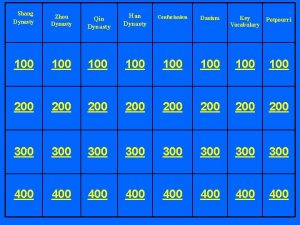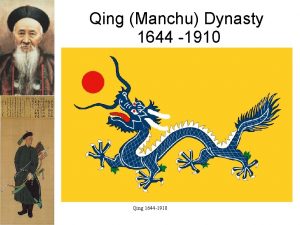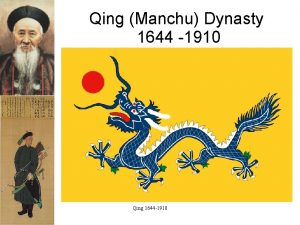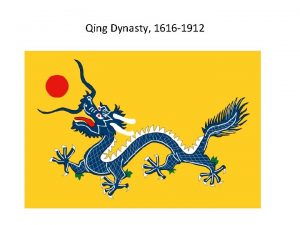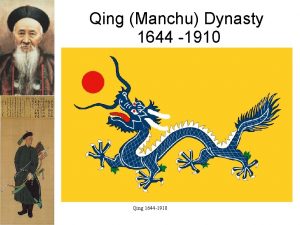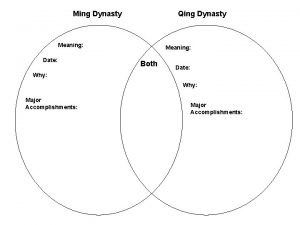The Decline of the Qing Dynasty China State
















- Slides: 16

The Decline of the Qing Dynasty (China) State Standard W. 19 Explain the growing influence of the West in China, the Boxer Rebellion, Sun Yat-sen and the Xinhai Revolution. I. Explain how the Opium War increased western influence in China. J. Explain how a series of revolutions weakened the Qing Dynasty’s rule over China and led to a shift of power by 1912.

I. Explain how the Opium War increased western influence in China. n n n Prior to the Opium War (1839 – 1842) China = isolated. Isolationism was spawned by desire to keep traditions intact. British had a trade deficit with China.

I. Explain how the Opium War increased western influence in China. n n n The British turned to trading Opium - caused social problems Silver Chinese attempted to use force to stop the opium trade.

I. Explain how the Opium War increased western influence in China. n In 1842, the Chinese were forced into the Treaty of Nanjing. Forced opening of ports (reparations, Hong Kong) n Western influence of China had begun. n Qing dynasty (government) weakens n

Assessment n Kahoot!

J. Explain how a series of revolutions weakened the Qing Dynasty’s rule over China and led to a shift of power by 1912. Taiping Rebellion When: 1850 – 1864 Who: Christian converts (Taipings/Hong Xuiquan) vs. Qing dynasty Why: Qing restriction of Christianity Casualties: 30 million (400, 000 soldiers) Outcome: British help re-establish Qing

J. Explain how a series of revolutions weakened the Qing Dynasty’s rule over China and led to a shift of power by 1912. Boxer Rebellion When: 1899 - 1901 Who: “Boxers” and Qing dynasty vs. imperializing nations Why: fed up with westernization Outcome: Boxer protocol – western nations put down rebellion, allowed Qing dynasty to continue rule

Assessment 1. 2. 3. 4. 5. Who fought the Taiping Rebellion? Why? What was the outcome? Who fought the Boxer Rebellion? Why? What was the outcome? How did western ideas such as Christianity play a role in each rebellion?

E. Explain how a series of revolutions weakened the Qing Dynasty’s rule over China and led to a shift of power by 1912. n Rebellions continued: n n n Boxer Rebellion (1899 – 1901): After the Qing Dynasty established an Open Door policy to the west, members of a secret shadowboxing organization became upset with the growing influence of the west and poor economic conditions. In response, the Boxers began to roam the country side to “destroy the foreigner” and slaughtered thousands of foreign missionaries and Chinese Christians. In response, an allied army consisting of those nations with an interest in China, put down the rebellion.

E. Explain how a series of revolutions weakened the Qing Dynasty’s rule over China and led to a shift of power by 1912. n n After the Boxer Rebellion, the Qing dynasty attempted one last time at enlightened reform, but failed for 3 reasons: The dynasty’s slow pace of reform upset the emerging new elite. The newly created assemblies (legislature) could not pass laws, but only advise the emperor. Living conditions for the lower class were also worsening.

Revolution in China n State Standard W. 19 Explain the growing influence of the West in China, the Boxer Rebellion, Sun Yat-sen and the Xinhai Revolution. K. Why did Sun Yat-sen form the Nationalist Party? L. How did the Xinhai Revolution transform China?

K. Why did Sun Yat-sen form the Nationalist Party? n In 1905, radical leader Sun Yat-sen formed the Revolutionary Alliance, which would later be known as the Nationalist Party. Qing Dynasty-brink of collapse. n China-new government- control imperializing nations. n Sun Yat-sen-prepare for democracy. n

K. Why did Sun Yat-sen form the Nationalist Party? n Sun Yat-sen set out a three-stage process to reform China: n n n Step 1: military take-over Step 2: prepare the people for a democratic government Step 3: establish a new constitutional democracy. 1908 -before reform-Empress Dowager Ci Xi died “last emperor, ” infant Henry Pu Yi

L. How did the Xinhai Revolution transform China? n October 1911 -Xinghai Revolution- Qing Dynasty officially collapsed. n Sun-no position to form a new government no military to back them. n They turned to General Yuan Shigai (initially backed the Qing), n In exchange, Yaun president

L. How did the Xinhai Revolution transform China? n n Yuan dissolved the newly created parliament and ruled through violence. After Yuan’s death in 1916, civil war erupted between Yuan’s officers and Sun’s National Party.

n L. How did the Xinhai Revolution transform China? In the process: Imperialists continue introduction of western ideas n Most profits were still going back into the pockets of the imperializing nations. n Warlordism n
 Chapter 26 lesson 1 the decline of the qing dynasty
Chapter 26 lesson 1 the decline of the qing dynasty Qing empire decline
Qing empire decline Qing qing ting lyrics
Qing qing ting lyrics Rise of the qing dynasty
Rise of the qing dynasty Ming dynasty time period
Ming dynasty time period The rise and fall of qing dynasty
The rise and fall of qing dynasty Qing dynasty dbq
Qing dynasty dbq Tang and song dynasty venn diagram
Tang and song dynasty venn diagram Qing china at its height
Qing china at its height Qing dynasty social classes
Qing dynasty social classes How did the zhou dynasty fall
How did the zhou dynasty fall The decline and fall of the romanov dynasty
The decline and fall of the romanov dynasty Qing china at its height
Qing china at its height Four chinese dynasties
Four chinese dynasties Ancient china han
Ancient china han The ming dynasty ended rule of china.
The ming dynasty ended rule of china. China zhou dynasty
China zhou dynasty
